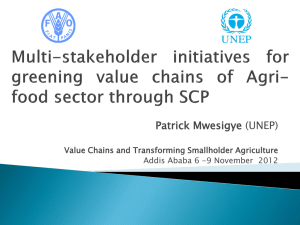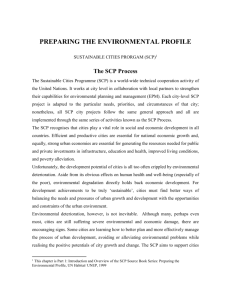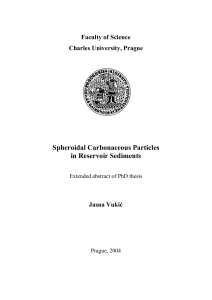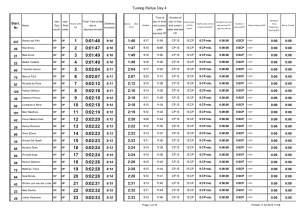MIP-based Detailed Placer for Mixed-size Circuits
advertisement
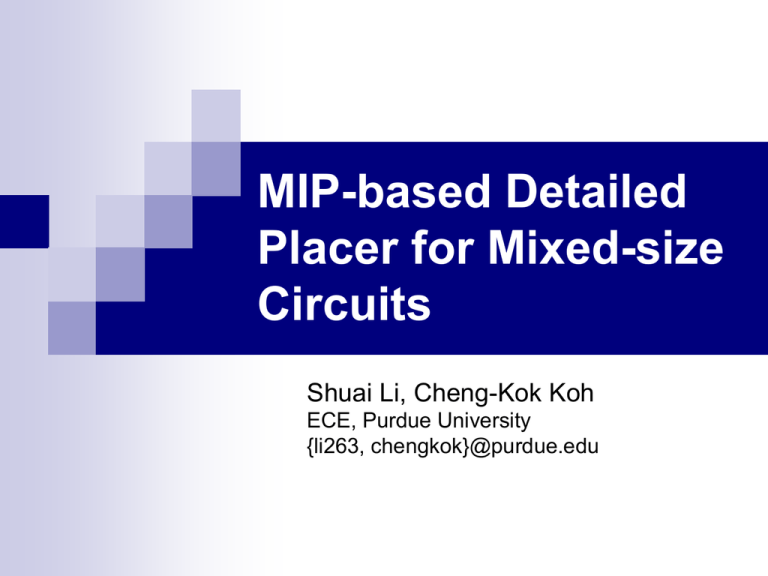
MIP-based Detailed
Placer for Mixed-size
Circuits
Shuai Li, Cheng-Kok Koh
ECE, Purdue University
{li263, chengkok}@purdue.edu
Outline
Motivation
Incomplete SCP model
Experimental results
Summary
Background
Placement
Global placement
minimize total wirelength,
estimated with half parameter
wirelength (HPWL)
routability-driven placement
avoid routing congestion
optimized approximate
locations;
Detailed placement
after legalization;
rearrange cells to reduce
HPWL
Detailed placement
cell swap/move technique
FastPlace-DP, global and vertical cell swap/move
congestion-aware FastPlace-DP, routability-driven placers
sliding window technique
partition the whole chip into overlapping windows
moving cells locally in windows has less perturbance to routability
enumeration approach;
solution space O(n!) for n-cell window;
windows with no more than 6 cells
alternative approaches to optimize larger windows
branch-and-bound technique, cell matching technique, etc.
MIP approach for detailed placement
Mixed Integer Programming (MIP) approach
placement of each window is formulated into an MIP problem:
linear objective function & linear constraints;
integer variables
mature mathematical techniques for solving MIP problems
a branch-and-bound tree is built during solution, whose size is
dependent on the number of integer variables
MIP models for detailed placement
the S model, the RQ model, the SCP model
the single-cell-placement (SCP) model
over 10 times more efficient than the other MIP models
MIP-based detailed placer
Parallelized MIP-based detailed placer
IBM Version 2 benchmark circuits
Initial placement results generated with enumeration approach;
1.684% further reduction in HPWL;
0.827% and 1.707% further reduction in routed wirelength and via
count, respectively.
Apply it to recent mixed-size circuits?
benchmark circuits in ISPD11, DAC12, ICCAD12 routability-driven
contests
Challenges with recent mixed-size circuits
DAC12 benchmark circuits
n.c. number of cells
o.r. occupation rate, the rate that sites are occupied by cells
400 extracted 10-cell windows
n.s. average number of sites
n.v. average number of integer variables in SCP model;
IBM Version 2
DAC12
Our contribution
DAC12 benchmark circuits
over 10 times more cells
over 2 times more sites in sliding windows
over 10 times increase in solution time of each window
Incomplete SCP model
ignore a portion of integer variables in SCP model
great reduction in solution time without much degradation in
solution quality
MIP-based detailed placer for DAC12 benchmark circuits
Outline
Motivation
Incomplete SCP model
Experimental results
Summary
Problem description
Objective: minimize HPWL
Constraints:
1.
2.
no cell overlap;
each cell is placed legally, i.e. cell c occupies exactly wc consecutive
sites in one row
R: set of rows
Q: set of columns
C: set of cells
wc: width of cell c
N: set of nets
Single-cell-placement variables
Single-cell-placement patterns and corresponding vectors
ck single-cell-placement (SCP) variable:
whether the kth pattern to place single cell c is chosen or not
e.g. cell 1 in the 3X7 window;
|R|(|Q|-wc+1)=18 variables in all
SCP Model
definition of bounding box
site occupation
cell centroid and site occupation variables
derived from SCP variables
one pattern for each cell
(llxn, llyn , urxn, uryn): bounding box of net n ;
(xc, yc): centroid of cell c;
pcrq : whether cell c occupies the site at row r and column q
Incomplete SCP Model
definition of bounding box
site occupation
cell centroid and site occupation variables
derived from SCP variables
one pattern for each cell
skipping patterns
Incomplete SCP Model (cont’d)
e.g. cell 1 in the 3X7 window;
|R|(|Q|-wc+1)=18 variables in all
oc = 1, when skip=3, only the 1st, 4th, 7th, 10th, 13th, 16th are kept
Incomplete SCP Model (cont’d)
Guideline to set skip
exact locations in the solution may be non-optimal
guarantee different orders of placing cells are still in the solution
space
skip=1 for compact windows;
larger skip for sparse windows with low occupation rate (ocp_rt)
and more empty sites
Two incomplete SCP models
Number of variables for cell c in SCP model:
vc | R | (| Q | wc 1) c | R || Q |, c (| Q | wc 1)/ | Q |
SCP_OR model, set skip based on occupation rate
skip round(1/ ocp _ rt ) round(| R || Q | / wc )
vc c | R || Q | / skip cO( wc )
c
c
vc is close to summation of cell width, the same as in the SCP model of
placing the same cells in a compact window
SCP_ES model, set skip based on number of empty sites
skip floor(empty_sites_cnt/|C|)+1=floor((1 opt _ rt ) | R || Q | / | C |) 1
vc c | R || Q | / skip
c
|C |
1 ocp _ rt
In compact windows, skip=1
In sparse windows with ocp_rt close to 0.0, vc is close to |C|, the same as in
the SCP model of placing the same number of uniform-width cells
Outline
Motivation
Incomplete SCP model
Experimental results
Summary
Effect of incomplete models
tolerance time 40s, 60s, 800s for 8-cell, 10-cell, 12-cell windows
SCP_OR model, a good compromise of the SCP model
fewer than a half integer variables (n.v. )
over 6 times faster (t(s)), within 10% degradation in HPWL reduction (red.)
SCP_ES model
1/5 variables, 100 times faster with 40% degradation
used in our parallelized MIP-based detailed placer
Enumeration approach (ENUM)
few windows are optimized with the same tolerance time
Results on DAC12 benchmark circuits
MIP-based detailed placer
2-row and 4-row windows with no more than 10 cells
windows are scanned for 3 times
Initial placement results generated by different placers
Ripple
NTUPlace4
Two commercial routers to generate detailed routing solutions
Router A, Router B
existing translator from Bookshelf files to LEF/DEF files
W.-H. Liu et al. Case study for placement solutions in ISPD11 and DAC12 routability-driven
placement contests. In Proc. ISPD, pages 114–119, 2013.
Effects on Ripple’s results
INIT: initial results generated with congestion-aware FastPlace-DP
MIP: results after MIP-based detailed placer
Router A
WL(e7): routed wirelength
VIA(e7): via count
VIO: number of detailed routing violations T(m): routing run-time
OF: overflows in global routing
Effects on NTUPlace4’s results
INIT: initial results generated with cell matching technique
MIP: results after MIP-based detailed placer
Router A
WL(e7): routed wirelength
VIA(e7): via count
VIO: number of detailed routing violations T(m): routing run-time
OF: overflows in global routing
Effects on Ripple’s results
INIT: initial results generated with congestion-aware FastPlace-DP
MIP: results after MIP-based detailed placer
Router B
Effects on NTUPlace4’s results
INIT: initial results generated with cell matching technique
MIP: results after MIP-based detailed placer
Router B
Outline
Motivation
Incomplete SCP model
Experimental results
Summary
Summary
MIP approach for detailed placement
optimize larger sliding windows to further reduce wirelength
Application in recent large-scale benchmark circuits
Over 10 times more cells;
Lower occupation rate leading to significant increase in the solution
time of each window
Incomplete SCP model
ignore variables to significantly decrease solution time;
Despite degradation in solution quality, still effective reduction in
wirelength is achieved without perturbance of routability
Thank you!
Large-scale mixed-size circuits
Larger solution space for windows with more empty sites
1-row window with n cells and m empty sites
More integer variables in MIP results in the increase of solution time
Over 300 randomly extracted windows
#cell
t(s)
opt
for each size
ibm01: IBM Version 2 benchmark
tolerance time 40s
ibm01
s16: DAC12 benchmark
tolerance time 40s, 60s, 800s for 8-cell,
10-cell, 12-cell windows, respectively
longer average solution time t(s)
s16
lower optimization rate opt
8-cell
0.82
100%
10-cell
1.93
99.7%
12-cell
5.86
96.4%
8-cell
9.2
94.4%
10-cell
19.6
90.7%
12-cell
113.3
76.8%




